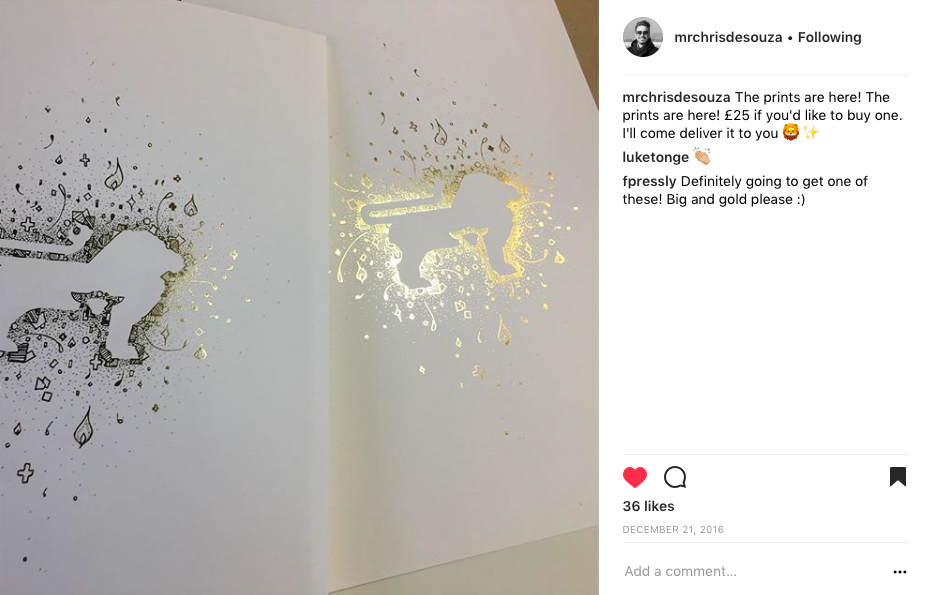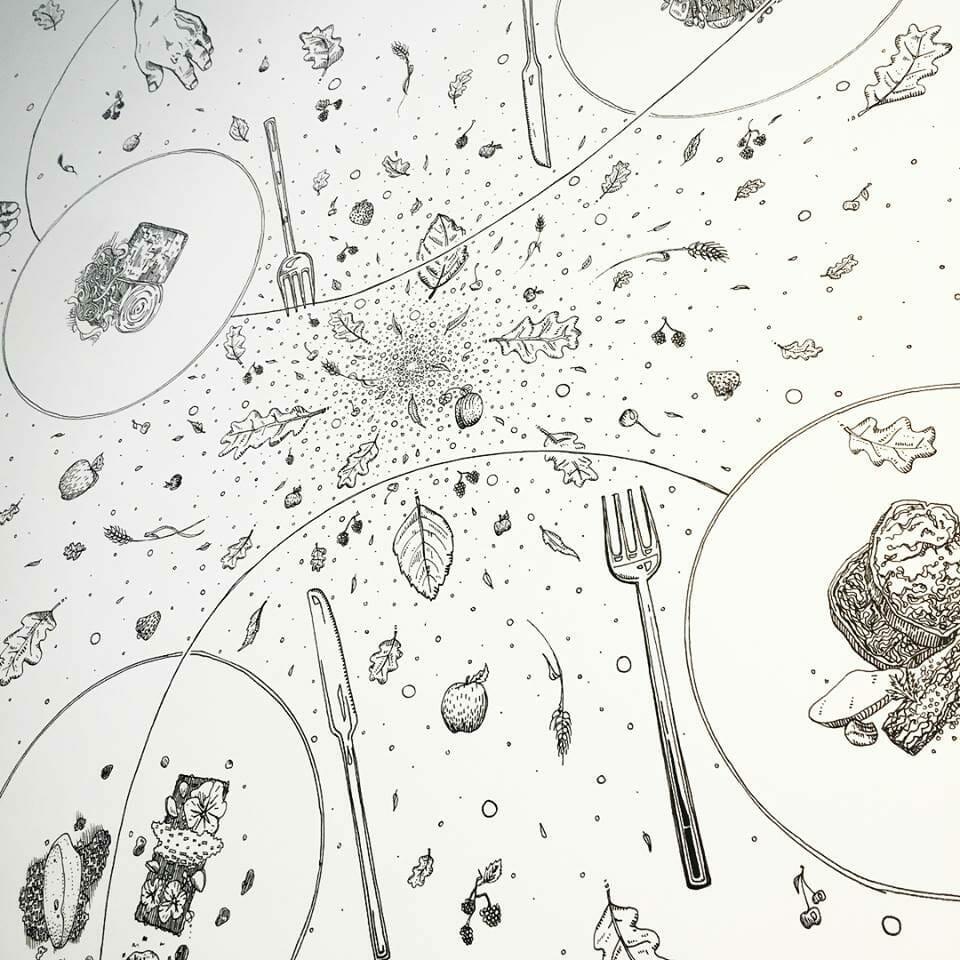
MEET THE MAKER
AN EXQUISITE COLLISION: ‘THE MANOR TABLE’
Chris Milne de Souza is the man behind ‘The Manor’s Table’. Literally behind if you’re looking at the image above, although he spent enough time bent over the 150 x 120cm ink on paper drawing. But obvious gift aside, Chris isn’t an artist by trade. He’s currently working as a UX designer (user experience designer to those of us not in the know), designing software for a bank. I ask him just how creative this role can get.
‘At the moment I do all of my drawings in my free time; it is something that I’ve always drawn satisfaction from [no pun intended]. Day to day at work I’m solving problems visually, but this involves relatively limited creativity in comparison to a purely artistic role. I did study Visual Communications at uni, but illustration wasn’t a key part of this.’
Scroll through Chris’ Instagram and it’s strewn with black ink illustrations with one-emoji-captions.

‘What I really love is taking a complex metaphor and trying to create it in an illustration. The drawings on my Instagram have deeper meanings that I don’t really share with people. The meanings are for me and that’s something I really delight in. A lot of what I’ve done so far has come out of big events in my life. In putting ink to paper I’m trying to communicate them and put across some of my thoughts on purpose and the themes that I see in the world. In the past, I have been quite protective of these intimate insights, but now I’m of the mind that if other people can enjoy them then all the better.’
I ask whether any of the drawings that feature on his Instagram have been commissioned.

‘Not really. I’d like to do more. Other than ‘The Manor’s Table’ there are two other things I’ve done: an illustration of a lion and a lamb which had a limited run of 100 prints [stalking this on Instagram how I wish I’d been one of the lucky 100], and then an exhibition for a church communicating something quite different. As things have come my way I’ve responded, but I’ve not proactively pursued.’
I’m interested to know how James and Fjona convinced Chris to do a piece for the Manor.
‘They sold me their vision based around the Arts and Crafts movement; that they wanted to fill the Manor with craftspeople and their wares, creating a community based around the applied arts; that they wanted to reclaim some of the themes that the Arts and Crafts movement tapped into. I love that movement; Pre-Raphealite artists, all that fantasy imagery, I think there’s something really rich in that. There are elements of that which I’d like to see more in my own artwork. The more James and Fjona told me, the more I realised they were articulating what I’ve always personally liked to communicate.’

We start to talk about the history of art. Chris lectured in Digital Media at the University of Birmingham, ‘predominantly on user experience and design’. But history of art is something that he’s delved into in his own time. He mentions the Bauhaus movement in Germany, explaining that it was the first school of art to be multi-disciplinary, teaching fine artists sculpture, and photographers fashion etcetera. It was pushing these arts together to create something new. Chris describes these as ‘exquisite collisions’, exciting things being created when different things come together. The moment that the Manor revels in, the time when guests come together around a table and something memorable, ‘that in itself is like an exquisite collision.’ The question is, how do you represent this exquisite collision in artistic form?

How did the collaborative process work?
‘I sat down for a really good de-brief and tour of the Manor. James and Fjona told me lots of stories about the people who work there (all your darkest secrets). This led to one of our initial concepts being based around hands. It would be a piece of art built out of the hands of the people who have made the Manor what it is today. But we actually decided that would work better as a photography piece. So back to the drawing board. I went away and came back with multiple sketches. We then honed through these, finally reaching a point at which we thought the concept of the illustration was refined. So it was like multiple rounds; a lot of collaboration between Fjona and myself.

How would you describe the final image?
‘Something that Fjona and James said was ‘in the heart of England a table is laid.’ For me, it’s about the idea of a shared meal as a place for connection, for community. So the illustration depicts a laid table with a single line that runs through it. This is the line of conversation that happens when people gather together. Then there’s the disruption to the line, the explosion. It’s that defining moment in a meal when things are realised, opinions are shared, and which will stand out when you look back at it. There is an exquisite collision of ideas. Hampton Manor wants to cultivate an arena for those defining moments.’

Logistically, how did it work creating an illustration on such a large scale?
‘[He laughs] luckily I have a very large table at home. I could lean over and draw on ink on it, which meant that a lot of it was drawn free-handed, so high risk [high gain, we might add]. I had the paper specially sent from a London merchant. It was one of those focussed activities that allowed me to think, almost like a therapy. I was immersed in my thoughts, pouring myself out into the drawing. I used to have a studio in Birmingham, but now I’m in the centre of London I dream of becoming a full-time artist with a studio that I could walk into…
And do you see that happening in your future?
‘I think anything is possible.’

